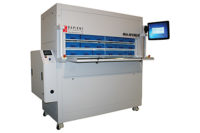Recently, there has been an unprecedented convergence of market factors driving the adoption of automation in the warehousing environment. Shifting consumer behaviors in retail environments results in smaller store footprints and the need for increased attention to intraday store replenishments, while the rise of e-commerce prompts similarly accelerated service level expectations for smaller quantities of products.
The outcome is increased pressure in the warehouse to respond to higher throughput and demand volatility. With the additional advantage of energy cost savings, this is especially true of refrigerated warehouses.
Traditional pallet level automated storage and retrieval systems (AS/RS) have long been viewed as a compelling option to improve capacity utilization. Increasingly, they are also being viewed as protection against rising challenges in workforce availability. The AS/RS environments essentially rely on cranes to perform automated storage of pallets in single-deep, double-deep or deeper locations. One consideration when designing these environments is that as the location configuration extends, complexities arise in the systemic management of those environments.
Single-deep location environments tend to work as an extension of the warehouse management systems, as the logic that directs a robotic crane can operate in the same fashion as would the logic that drives a forklift driver. Double-deep locations, however, require simple decision-making logic to identify and extract pallets in co-mingled locations, which a traditional warehouse management system (WMS) will not support. Some AS/RS will feature logic that can overcome this by temporarily (or permanently) moving the front pallet where appropriate, but it is fair to assume that this will bring with it inefficiencies relative to other picking locations that would need to be considered.
Would it be preferable to allocate from an alternative location that has the same product (and critically, relative freshness and quality) in a forward location that would offer a preferable pick scenario? This often begins a broader discussion of how to delineate the WMS logic from the AS/RS logic. While many AS/RS providers bring basic WMS capabilities to the forefront, such as inventory awareness and the ability to allocate product for efficient travel sequences of their equipment, they typically lack critical functionality required of perishables products typically stored in refrigerated environments, such as quality and shelf-life elements.
It is this focus on managing perishables with an eye toward minimizing distressed and spoiled inventories that differentiates leading WMS providers and enables their customers to drive operational efficiency and customer satisfaction in both traditional, semi-automated and fully automated environments. Attempting to split responsibilities with WES or WCS systems often results in imperfect solutions, unnecessary administration and reconciliation and dual maintenance of customer, item and warehouse configurations. The effort to establish redundant logic across systems to serve the same purpose certainly isn’t an attractive one.
Is there an operational alternative? The most straightforward approach would be to simply prevent the AS/RS from co-mingling products in double-deep locations, and while this may seem an easy solution, date codes or lots must also be considered for segregation, as they will too exhibit unique status and shelf-life elements, and therefore require segregation from same-SKU pallets. It is fair to expect that this will come with some impact to capacity utilization, which is after all, one of the more compelling drivers for adoption of AS/RS in warehousing environments.
Consider that this approach is most attractive for high-velocity products, especially when those products are fairly bulky in nature. Perhaps those products that allow for longer production runs and results in high numbers of pallets produced per line by date should be expected to warrant the largest number of deeper locations, and therefore businesses that have fairly low SKU counts, but see high volume throughput are the most obvious candidates. Some industries, such as dairy, are exceptionally well positioned for this approach. Similarly, products with longer shelf lives can be produced in larger quantities, less frequently, and therefore, offer more consistency across lots, which promote opportunities for higher concentration and capacity utilization. Others, however, may need to explore hybrid solutions to capitalize on the inherent promise of an AS/RS without disrupting the justification for the projects by introducing unnecessary systems implementation and maintenance costs.
For those organizations with a higher distribution of fast vs. slow-moving products, AS/RS simulations can also be used to consider utilization targets along with growth projections to chart out optimal location sizing mechanisms, which may require a collection of single, double, triple and beyond-sized locations that best fit the velocity profiles to optimize utilization of the AS/RS.
Similarly, a manual storage and selection capability, accentuated by an AS/RS that can handle the lion’s share of the work, is an attractive option. This approach features flexible racking mechanisms in the manual areas, at best, providing more responsiveness to demand volatility, and at worst, a less capital-intensive investment that accommodates greater agility.
No matter the approach that best fits your business, the adoption of an AS/RS offers a strong opportunity to improve speed, throughput and efficiencies, but also brings the danger of an inflexible, costly environment that can require continued attention and maintenance. The key is to ensure the solution is conceptualized with a full vision of the fit into the overall warehouse environment and is flexible to accommodate changes in demand profiles.



